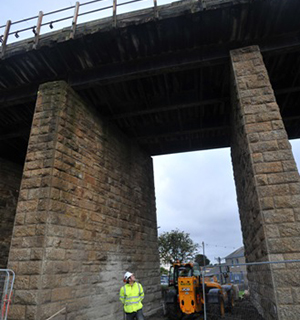
D-Drill helps to save historic structure
D-Drill’s skilled operatives have helped to save a historic viaduct in Cornwall.
 A team of drillers, led by Plymouth-office manager Ed Taylor, worked with main contractor Bam Nuttall to help stabilise the Hayle Viaduct which was originally designed by Isambard Kingdom Brunel in 1852.
A team of drillers, led by Plymouth-office manager Ed Taylor, worked with main contractor Bam Nuttall to help stabilise the Hayle Viaduct which was originally designed by Isambard Kingdom Brunel in 1852.
The viaduct was beginning to subside and urgent action was required to prevent it from happening.
The decision was taken to insert four ‘I’ shape structure beams into the granite pillars. Each beam weighed 600 kilogrammes and measured three metres in length.
That meant the need for ‘I’ shape holes 1.5m deep into the granite each side of the pillar with just a 20mm void around the beam to allow for grouting with concrete. That challenging task fell to D-Drill.
Two separate teams, including those who have come up through the company’s apprenticeship programme, were assigned to the task but only one pillar could be worked on at a time because it was crucial not to jeopardise the strength of the support for the viaduct.
For each ‘I’, around eight holes needed to be created and, to make matters even more difficult, the pillars are twisted in a curve which meant that all 128 holes had to be angled.
After a total of 20 working days, each ‘I’ shaped slot had been created and enabled Bam Nuttall to insert the stabilising metal beams to rescue the historic viaduct.
“We averaged 13 holes a day which meant 19.5m of drilling at 152mm in diameter – which is no mean feat when you are going into granite,” said Ed Taylor of D-Drill.
“One slip, one miscalculation could have set the whole project back or, worse still, jeopardised this historic viaduct.
“As well as myself, we had the team’s most experienced drillers working on this job and we were delighted with the result.
“Setting up on uneven surfaces requires experience along with logical and innovative thinking. We utilised wedges, plates and wooden soldiers to ensure the rig was level and that we were ‘aiming’ at the right angle.
“I am delighted to say that the job was a complete success and we are proud to have played our part in preserving a piece of engineering history.”
Back to Projects